IT___
Gli anni del teatro e delle realizzazioni scenografiche rappresentano il bagaglio più importante della mia formazione artistica e professionale.
Dalle aule dell’Accademia, sui cui tavoli i sogni sono disegnati su carta, alle realizzazioni per le tavole del palcoscenico la cui polvere, densa e acre, in alcune occasioni mette a dura prova la passione per una professione unica ma che richiede grande sacrificio e abnegazione.
Dalle aule dell’Accademia, sui cui tavoli i sogni sono disegnati su carta, alle realizzazioni per le tavole del palcoscenico la cui polvere, densa e acre, in alcune occasioni mette a dura prova la passione per una professione unica ma che richiede grande sacrificio e abnegazione.
Alle collaborazioni come assistente degli scenografi Lorenzo Ghiglia, Gianni Carluccio e Giacomo Andrico, affianca l'attività di scenografa.
Ha collaborato come assistente scenografa di Gianni Carluccio e come scenografa alle scene degli spettacoli del Gruppo Della Rocca per la rassegna "Cantiere di fine Millennio" sul teatro da camera di August Strindberg. In questa occasione, come assistente scenografa di Lorenzo Ghiglia, collabora anche alla messa in scena de "Il Pellicano" dell'autore drammaturgo svedese, per la regia di Mario Missiroli.
Alla fine degli anni novanta, la collaborazione con la Fondazione Italiana per la Fotografia di Torino (FIF) e la produzione di alcuni spettacoli i cui testi drammaturgici esplorano la fotografia nella messa in scena teatrale, comincia la sperimentazione in un nuovo ambito progettuale con le scenografie multimediali e la produzione dei contributi video per gli spettacoli. La regia degli spettacoli è affidata a Oliviero Corbetta del Gruppo della Rocca. Gli spettacoli prodotti e allestiti per la FIF sono stati raccolti nel libro "Foto in Scena. La fotografia a Teatro" pubblicato nel 2004 da Falsopiano editore.
Nel 2000, in occasione delle celebrazioni per il Giubileo, è assistente scenografa di Giacomo Andrico per l'allestimento dello spettacolo "Una notte con Caligola" per la regia di Mauro Avogadro, prodotto dal Teatro Stabile di Torino e Roma.
Dopo quasi dieci anni di attività, dagli inizi con il teatro di marionette della storica famiglia Lupi della città di Torino, agli spettacoli allestiti per il teatro di ricerca del Gruppo della Rocca e altre realtà teatrali nazionali, il percorso si interrompe agli inizi degli anni Duemila.
EN___
The years of theater and scenographic achievements represent the most important baggage of my artistic and professional training.
From the classrooms of the Academy, on tables of which dreams are drawn on paper, to the creations for the tables of the stage whose dust, dense and acrid, on some occasions puts a strain on the passion for a unique profession that requires great sacrifice and self-denial.
From the classrooms of the Academy, on tables of which dreams are drawn on paper, to the creations for the tables of the stage whose dust, dense and acrid, on some occasions puts a strain on the passion for a unique profession that requires great sacrifice and self-denial.
In addition to the role of assistant for the set designers Lorenzo Ghiglia, Gianni Carluccio and Giacomo Andrico, she’s also been a set designer herself.
She collaborated as an assistant set designer and set designer of Gianni Carluccio on the scenes of the Rocca Group shows for the review "Construction site of the Millennium end" at August Strindberg's chamber theater. On this occasion, as assistant scenographer to Lorenzo Ghiglia, she also collaborated in the staging of "Il Pellicano" written by Swedish playwright and directed by Mario Missiroli.
At the end of the nineties, the collaboration with the Italian Foundation for Photography of Turin (FIF) and the production of some shows whose dramaturgical texts explore photography in theatrical staging, saw the start of some experimentation in a new design field by means of multimedia scenography and the production of video contributions for shows. The direction of the shows was entrusted to Oliviero Corbetta of the Rocca Group. The shows of FIF were collected in the book Photos on stage photography in the theater in 2004 by Falsopiano editions.
In 2000, on the occasion of the Jubilee celebrations, she served as assistant set designer to Giacomo Andrico for the staging of the show "A night with Caligola" directed by Mauro Avogadro and , produced by Teatro Stabile of Turin and Rome.
After almost ten years of activity, from the puppet theater of the historic Lupi family of Turin, to the shows set up for the Rocca Group research theater and other national theaters, the beginning of the year 2000 saw an interruption in her path.
IN VIAGGIO CON MARGARET (TRAVELING WITH MARGARET)
Fondazione Italiana per la Fotografia di Torino (F.I.F.)
Stage performance with guided tour to Margaret Bourke White exhibition
Direction: Oliviero Corbetta
Actors: Gabriele Calindri, Maddalena Vadacca, Patrizia Scianca, Oliviero Corbetta
Set design - Scenographic staging - Costumes - Technical supervisor: Monica Chiappara
Light design - Technical direction: Davide Leone
Production: F.I.F. - 2000
IT___
Nelle sale espositive della FIF è stato realizzato l’allestimento per le performance d’accompagnamento alla mostra fotografica di Margaret Bourke-White.
“In viaggio con Margaret” è stata un’opportunità per applicare i materiali normalmente utilizzati per gli allestimenti scenografici teatrali, come il “cencio di nonna” e la “tela grezza” per realizzare i mini sipari simili ai secondi sipari chiamati “comodino”, dei velari in tela ignifuga montati ad arte su cantinelle portanti con alzata a sipario alla “tedesca", supportati da un meccanismo scenotecnico detto “a ghigliottina”.
Tale meccanismo è stato realizzato in entrambe le direzioni: dall’alto verso il basso e dal basso verso l’alto, per mascherare i cambi di scena. Fissati alle pareti, in sostituzione del classico mantegno teatrale, hanno avuto la funzione di raccogliere e fermare le corde di sollevamento dei fondalini che scorrevano su binari a carrucola fissa.
I piccoli sipari sono stati utilizzati per scoprire soltanto durante le performance gli elementi scenici nascosti allo sguardo dei visitatori della mostra.
La parte illuminotecnica ha previsto l’uso di mini sagomatori per le opere fotografiche incluse nel percorso di visita guidata e proiettori teatrali per le performance degli attori.
In particolare l’utilizzo di un sagomatore puntato su uno schermo di tela ha proiettato, con la tecnica illuministica del teatro delle ombre, la silhouette dell’attore per la performance relativa alla foto che ritrae Gandhi vicino all’arcolaio a Poona nel 1946.
Uno specchio posto sopra le opere fotografiche esposte è svelato durante la performance collegata alla foto di Margaret Bourke-White “New York - 1930; Hats in the Garment District”, in cui gli attori sono riflessi nello specchio montato a parete, restituendo agli spettatori una vista dall’alto del passaggio di uomini con il cappello come nello scatto fotografico.
Un tappeto elastico ha accompagnato il volo di Icaro, sempre interpretato da Gabriele Calindri che ha recitato a soggeto davanti all’opera fotografica “DC-4 flying over Manhattan” del 1939.
All’ingresso principale della Fondazione è montata su alluminio una riproduzione della foto di Margaret Bourke-White sul Chrysler Building fotografata da Oscar Graubner.
Idealmente la fotoreporter di Life, con la sua Corona View 5×7, fotografa un frammento del Prometeo Incatenato di Eschilo, sospeso e addomesticato a cavallo della ringhiera delle scale dai due attori Gabriele Calindri e Maddalena Vadacca.
Come in camera oscura l’esposizione del negativo alla luce diventa fotografia, così lo spazio della FIF diventa luogo interpretativo delle immagini di Margaret Bourke-White.
Una lastra di vetro è la pagina trasparente su cui è scritto il testo recitato da Patrizia Scianca.
La sala espositiva che ospita le fotografie di Margaret Bourke-White dei reportage del campo di Buchenwald, la Russia degli anni Quaranta, il periodo indiano e il ritratto di Ghandi, la guerra di Corea, ritratti di persone comuni, ospita anche il site specific progettato per analizzare in modo critico lo scatto di Margaret Bourke-White della guerra di Corea del 1952.
L’installazione è composta da materiali che sintetizzano il concetto sperimentato fin dall’epoca Rinascimentale e rivisitato dalle Avanguardie artistiche del Novecento, la percezione prospettica ottenuta con l’illusione dell’immagine proiettata su una superficie riflettente: un supporto in ferro a base quadrata sopra il quale sono posizionati uno specchio con cornice in legno su cui è applicato l'adesivo di una riproduzione della Medusa di Caravaggio e la foto di Margaret Bourke-White che ritrae la testa di un guerrigliero nord coreano; filo di ferro per regolare l’angolo di inclinazione della superficie piane della foto e dello specchio. La provocazione di due immagini a confronto per suggerire una lettura senza dogmi sul potere orrorifero della guerra, dalla sua forma più "pop" legata al mito di Medusa con l'immagine di Caravaggio alla pietrificazione emotiva dopo la visione della rappresentazione del reale della foto di Margaret Bourke White. Medusa di Caravaggio, secondo gli studi critici è il volto autoritratto dell'artista italiano su cui pendeva implacabile la pena capitale a seguito di una condanna per omicidio, è presa d'esempio per la natura del suo mito essendo l'unica delle tre Gorgoni, figlie delle divinità marine Forco e Ceto di origine greca, investita della mortalità come gli esseri umani. Caravaggio si immedesima nel mito di Medusa nonostante la propria natura mortale di essere umano. Inoltre il viaggio in Italia di Margaret Bourke-White e le sue incursioni sul fronte di guerra italiano mi suggerivano la conoscenza da parte della fotografa statunitense dell'arte italiana. La verità ha i suoi personaggi “invisibili" e in “scena”. Tra realtà e verità c’è il filtro del non detto, del non visto e del non conoscibile.
“In viaggio con Margaret” è stata un’opportunità per applicare i materiali normalmente utilizzati per gli allestimenti scenografici teatrali, come il “cencio di nonna” e la “tela grezza” per realizzare i mini sipari simili ai secondi sipari chiamati “comodino”, dei velari in tela ignifuga montati ad arte su cantinelle portanti con alzata a sipario alla “tedesca", supportati da un meccanismo scenotecnico detto “a ghigliottina”.
Tale meccanismo è stato realizzato in entrambe le direzioni: dall’alto verso il basso e dal basso verso l’alto, per mascherare i cambi di scena. Fissati alle pareti, in sostituzione del classico mantegno teatrale, hanno avuto la funzione di raccogliere e fermare le corde di sollevamento dei fondalini che scorrevano su binari a carrucola fissa.
I piccoli sipari sono stati utilizzati per scoprire soltanto durante le performance gli elementi scenici nascosti allo sguardo dei visitatori della mostra.
La parte illuminotecnica ha previsto l’uso di mini sagomatori per le opere fotografiche incluse nel percorso di visita guidata e proiettori teatrali per le performance degli attori.
In particolare l’utilizzo di un sagomatore puntato su uno schermo di tela ha proiettato, con la tecnica illuministica del teatro delle ombre, la silhouette dell’attore per la performance relativa alla foto che ritrae Gandhi vicino all’arcolaio a Poona nel 1946.
Uno specchio posto sopra le opere fotografiche esposte è svelato durante la performance collegata alla foto di Margaret Bourke-White “New York - 1930; Hats in the Garment District”, in cui gli attori sono riflessi nello specchio montato a parete, restituendo agli spettatori una vista dall’alto del passaggio di uomini con il cappello come nello scatto fotografico.
Un tappeto elastico ha accompagnato il volo di Icaro, sempre interpretato da Gabriele Calindri che ha recitato a soggeto davanti all’opera fotografica “DC-4 flying over Manhattan” del 1939.
All’ingresso principale della Fondazione è montata su alluminio una riproduzione della foto di Margaret Bourke-White sul Chrysler Building fotografata da Oscar Graubner.
Idealmente la fotoreporter di Life, con la sua Corona View 5×7, fotografa un frammento del Prometeo Incatenato di Eschilo, sospeso e addomesticato a cavallo della ringhiera delle scale dai due attori Gabriele Calindri e Maddalena Vadacca.
Come in camera oscura l’esposizione del negativo alla luce diventa fotografia, così lo spazio della FIF diventa luogo interpretativo delle immagini di Margaret Bourke-White.
Una lastra di vetro è la pagina trasparente su cui è scritto il testo recitato da Patrizia Scianca.
La sala espositiva che ospita le fotografie di Margaret Bourke-White dei reportage del campo di Buchenwald, la Russia degli anni Quaranta, il periodo indiano e il ritratto di Ghandi, la guerra di Corea, ritratti di persone comuni, ospita anche il site specific progettato per analizzare in modo critico lo scatto di Margaret Bourke-White della guerra di Corea del 1952.
L’installazione è composta da materiali che sintetizzano il concetto sperimentato fin dall’epoca Rinascimentale e rivisitato dalle Avanguardie artistiche del Novecento, la percezione prospettica ottenuta con l’illusione dell’immagine proiettata su una superficie riflettente: un supporto in ferro a base quadrata sopra il quale sono posizionati uno specchio con cornice in legno su cui è applicato l'adesivo di una riproduzione della Medusa di Caravaggio e la foto di Margaret Bourke-White che ritrae la testa di un guerrigliero nord coreano; filo di ferro per regolare l’angolo di inclinazione della superficie piane della foto e dello specchio. La provocazione di due immagini a confronto per suggerire una lettura senza dogmi sul potere orrorifero della guerra, dalla sua forma più "pop" legata al mito di Medusa con l'immagine di Caravaggio alla pietrificazione emotiva dopo la visione della rappresentazione del reale della foto di Margaret Bourke White. Medusa di Caravaggio, secondo gli studi critici è il volto autoritratto dell'artista italiano su cui pendeva implacabile la pena capitale a seguito di una condanna per omicidio, è presa d'esempio per la natura del suo mito essendo l'unica delle tre Gorgoni, figlie delle divinità marine Forco e Ceto di origine greca, investita della mortalità come gli esseri umani. Caravaggio si immedesima nel mito di Medusa nonostante la propria natura mortale di essere umano. Inoltre il viaggio in Italia di Margaret Bourke-White e le sue incursioni sul fronte di guerra italiano mi suggerivano la conoscenza da parte della fotografa statunitense dell'arte italiana. La verità ha i suoi personaggi “invisibili" e in “scena”. Tra realtà e verità c’è il filtro del non detto, del non visto e del non conoscibile.
Ricorro all'artificio dello specchio, legittimata dalla percezione inconscia della sopravvivenza al caso, convinta dallo stupore e dalla semplicità comunicativa suscitata dagli “specchi segreti” e “metafisici” costruiti dal Timoteo protagonista del “Fabbricante di specchi” di Primo Levi, la cui lettura vent'anni dopo questa esperienza mi conferma la natura transitoria dell'immagine riflessa del sé ed ho costruito anch'io uno specchio grande come un biglietto da visita.
Dietro lo specchio di Medusa le foto esposte realizzate da Margaret Bourke-White e pubblicate dalla rivista LIFE.
EN___
The set-up, created in the FIF exhibition halls, for the accompanying performances to the photographic exhibition by Margaret Bourke-White.
"Traveling with Margaret" was an opportunity to apply the materials normally used for theatrical scenographic settings, such as the "grandmother's rag" and the "rough canvas", to create the mini backdrops similar to the second backdrops called "bedside table",
It also allowed the production of velariums in fireproof canvases artfully assembled on load-bearing cellars with a “German” curtain lift, supported by a scenic mechanism called the “guillotine”.
This mechanism was implemented in both directions – from top to bottom and from bottom to top – to mask scene changes. Screw eyelets fixed to the walls, replacing the classic theatrical support, had the function of collecting and stopping the lifting ropes of the backdrops that ran on fixed pulley tracks.
The small curtains were only used to uncover the scenic elements hidden from the gaze of the exhibition visitors during the performances. Lighting involved the use of mini shapers for the photography included in the guided tour and theatrical projectors for the acting performances.
For example, a shaper pointed at a canvas screen, with the shadow theater lighting technique, projected an actor’s silhouette for a performance relating to the 1946 photo of Ghandi near the spinning wheel in Poona, India.
A mirror placed over the photographic displays was unveiled during the performance linked to Margaret Bourke-White's photo “New York - 1930; Hats in the Garment District ", in which the actors were reflected in a mirror mounted on the wall, giving spectators a view from above of the passage of men with hats as in the photo shoot. A trampoline accompanied the flight of Icarus, again interpreted by Gabriele Calindri who acted in front of the 1939 photographic work "DC-4 flying over Manhattan”. A reproduction of Margaret Bourke-White's photo on the Chrysler Building, photographed by Oscar Graubner, was fixed on aluminum at the main entrance of the Foundation. Ideally, the Life photojournalist, with her Corona View 5 × 7, photographs a fragment of Aeschylus' Chained Prometheus, suspended and “tamed” astride the railing of the stairs by the two actors Gabriele Calindri and Maddalena Vadacca. Just as in the dark room, the exposure of the negative to light becomes photography, so the space of the FIF becomes an interpretative place for Margaret Bourke-White's images. A glass plate is the transparent page on which the text recited by Patrizia Scianca is written. The exhibition hall that houses Margaret Bourke-White's photographs of the Buchenwald camp reports, Russia in the 1940s, the Indian period, the portrait of Ghandi, the Korean War and portraits of ordinary people, also hosts a site specifics designed to critically analyze Margaret Bourke-White's snapshot of the 1952 Korean War. The installation is made up of materials that summarize the concept experimented since the Renaissance era and revisited by the artistic Avant-gardes of the twentieth century; the perspective obtained by with the illusion of an the image projected on a reflective surface: This illusion consists of an iron support with a square base above it, on which a mirror with a wooden frame is positioned. Then a sticker of a reproduction of the Medusa by Caravaggio and a photo by Margaret Bourke-White of the head of a North Korean guerrilla are applied on the wooden frame; iron wire to adjust the angle of inclination of the flat surfaces of the photo and mirror. The two images are contrasted as a provocation, a suggestion to a reading without dogmas of the horrifying power of war, from its more "pop" form linked to the myth of Medusa with the image of Caravaggio to the emotional petrification after viewing the representation of reality in the photo of Margaret Bourke White. According to critical studies, Medusa by Caravaggio as the self-portrait of the Italian artist on which the death penalty was relentless following a conviction for murder, is taken as an example for the nature of Medusa’s myth of being the only one of the three Gorgons, daughters of the Greek marine deities Forco and Ceto, invested in mortality like human beings.
Caravaggio identifies with the myth of Medusa despite his own mortal nature as a human being.
Furthermore, Margaret Bourke-White's trip to Italy and her forays on the Italian war front suggests the American photographer's knowledge of Italian art. The truth has its "invisible" and "on stage" characters. Between reality and truth there is the filter of the unspoken, the unseen and the unknowable.
I resort to the artifice of the mirror, legitimized by the unconscious perception of survival by chance, convinced by the amazement and communicative simplicity aroused by the "secret mirrors" and "metaphysics" built by Timothy, protagonist of Primo Levi's "Mirror maker", whose reading twenty years after this experience confirms the transitory nature of the reflected image of thy self and I too have built a mirror the size of a business card.
It also allowed the production of velariums in fireproof canvases artfully assembled on load-bearing cellars with a “German” curtain lift, supported by a scenic mechanism called the “guillotine”.
This mechanism was implemented in both directions – from top to bottom and from bottom to top – to mask scene changes. Screw eyelets fixed to the walls, replacing the classic theatrical support, had the function of collecting and stopping the lifting ropes of the backdrops that ran on fixed pulley tracks.
The small curtains were only used to uncover the scenic elements hidden from the gaze of the exhibition visitors during the performances. Lighting involved the use of mini shapers for the photography included in the guided tour and theatrical projectors for the acting performances.
For example, a shaper pointed at a canvas screen, with the shadow theater lighting technique, projected an actor’s silhouette for a performance relating to the 1946 photo of Ghandi near the spinning wheel in Poona, India.
A mirror placed over the photographic displays was unveiled during the performance linked to Margaret Bourke-White's photo “New York - 1930; Hats in the Garment District ", in which the actors were reflected in a mirror mounted on the wall, giving spectators a view from above of the passage of men with hats as in the photo shoot. A trampoline accompanied the flight of Icarus, again interpreted by Gabriele Calindri who acted in front of the 1939 photographic work "DC-4 flying over Manhattan”. A reproduction of Margaret Bourke-White's photo on the Chrysler Building, photographed by Oscar Graubner, was fixed on aluminum at the main entrance of the Foundation. Ideally, the Life photojournalist, with her Corona View 5 × 7, photographs a fragment of Aeschylus' Chained Prometheus, suspended and “tamed” astride the railing of the stairs by the two actors Gabriele Calindri and Maddalena Vadacca. Just as in the dark room, the exposure of the negative to light becomes photography, so the space of the FIF becomes an interpretative place for Margaret Bourke-White's images. A glass plate is the transparent page on which the text recited by Patrizia Scianca is written. The exhibition hall that houses Margaret Bourke-White's photographs of the Buchenwald camp reports, Russia in the 1940s, the Indian period, the portrait of Ghandi, the Korean War and portraits of ordinary people, also hosts a site specifics designed to critically analyze Margaret Bourke-White's snapshot of the 1952 Korean War. The installation is made up of materials that summarize the concept experimented since the Renaissance era and revisited by the artistic Avant-gardes of the twentieth century; the perspective obtained by with the illusion of an the image projected on a reflective surface: This illusion consists of an iron support with a square base above it, on which a mirror with a wooden frame is positioned. Then a sticker of a reproduction of the Medusa by Caravaggio and a photo by Margaret Bourke-White of the head of a North Korean guerrilla are applied on the wooden frame; iron wire to adjust the angle of inclination of the flat surfaces of the photo and mirror. The two images are contrasted as a provocation, a suggestion to a reading without dogmas of the horrifying power of war, from its more "pop" form linked to the myth of Medusa with the image of Caravaggio to the emotional petrification after viewing the representation of reality in the photo of Margaret Bourke White. According to critical studies, Medusa by Caravaggio as the self-portrait of the Italian artist on which the death penalty was relentless following a conviction for murder, is taken as an example for the nature of Medusa’s myth of being the only one of the three Gorgons, daughters of the Greek marine deities Forco and Ceto, invested in mortality like human beings.
Caravaggio identifies with the myth of Medusa despite his own mortal nature as a human being.
Furthermore, Margaret Bourke-White's trip to Italy and her forays on the Italian war front suggests the American photographer's knowledge of Italian art. The truth has its "invisible" and "on stage" characters. Between reality and truth there is the filter of the unspoken, the unseen and the unknowable.
I resort to the artifice of the mirror, legitimized by the unconscious perception of survival by chance, convinced by the amazement and communicative simplicity aroused by the "secret mirrors" and "metaphysics" built by Timothy, protagonist of Primo Levi's "Mirror maker", whose reading twenty years after this experience confirms the transitory nature of the reflected image of thy self and I too have built a mirror the size of a business card.
Behind the mirror of Medusa are photos on display made by Margaret Bourke-White and published by LIFE magazine.
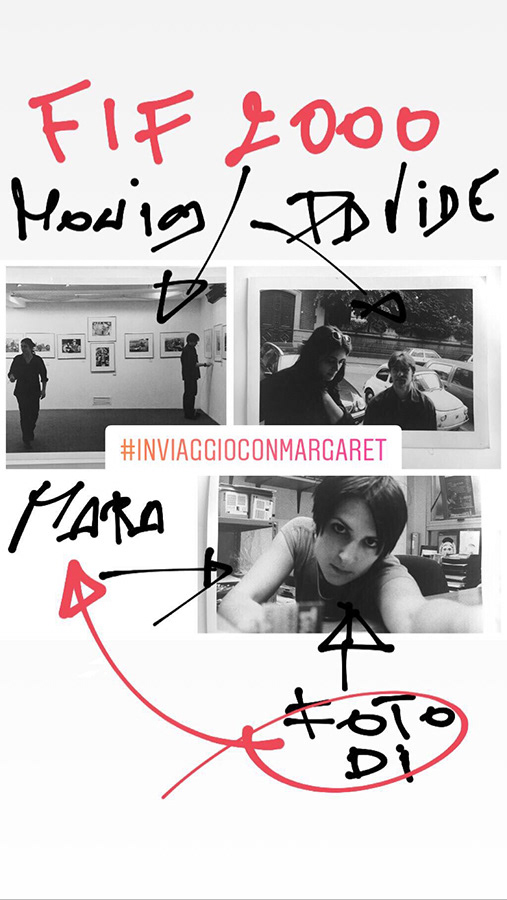
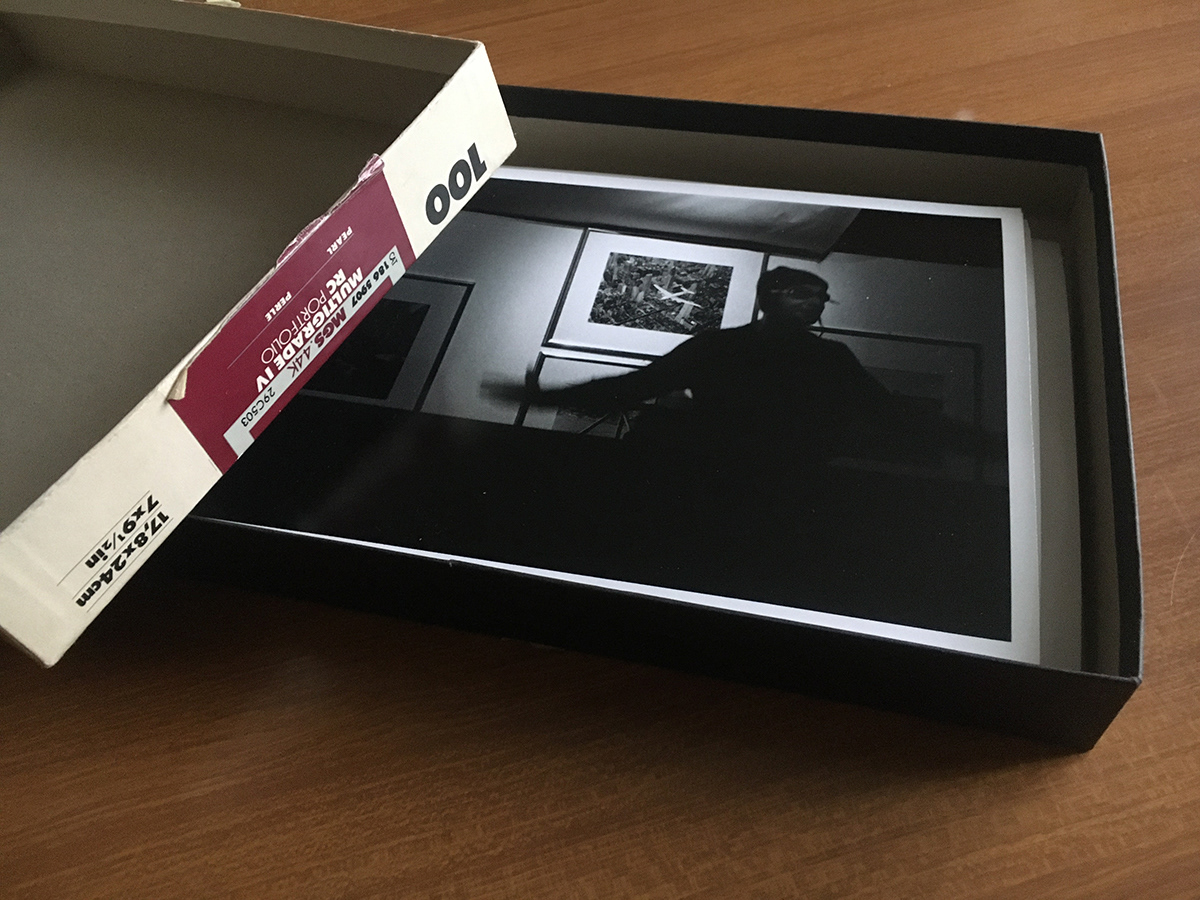
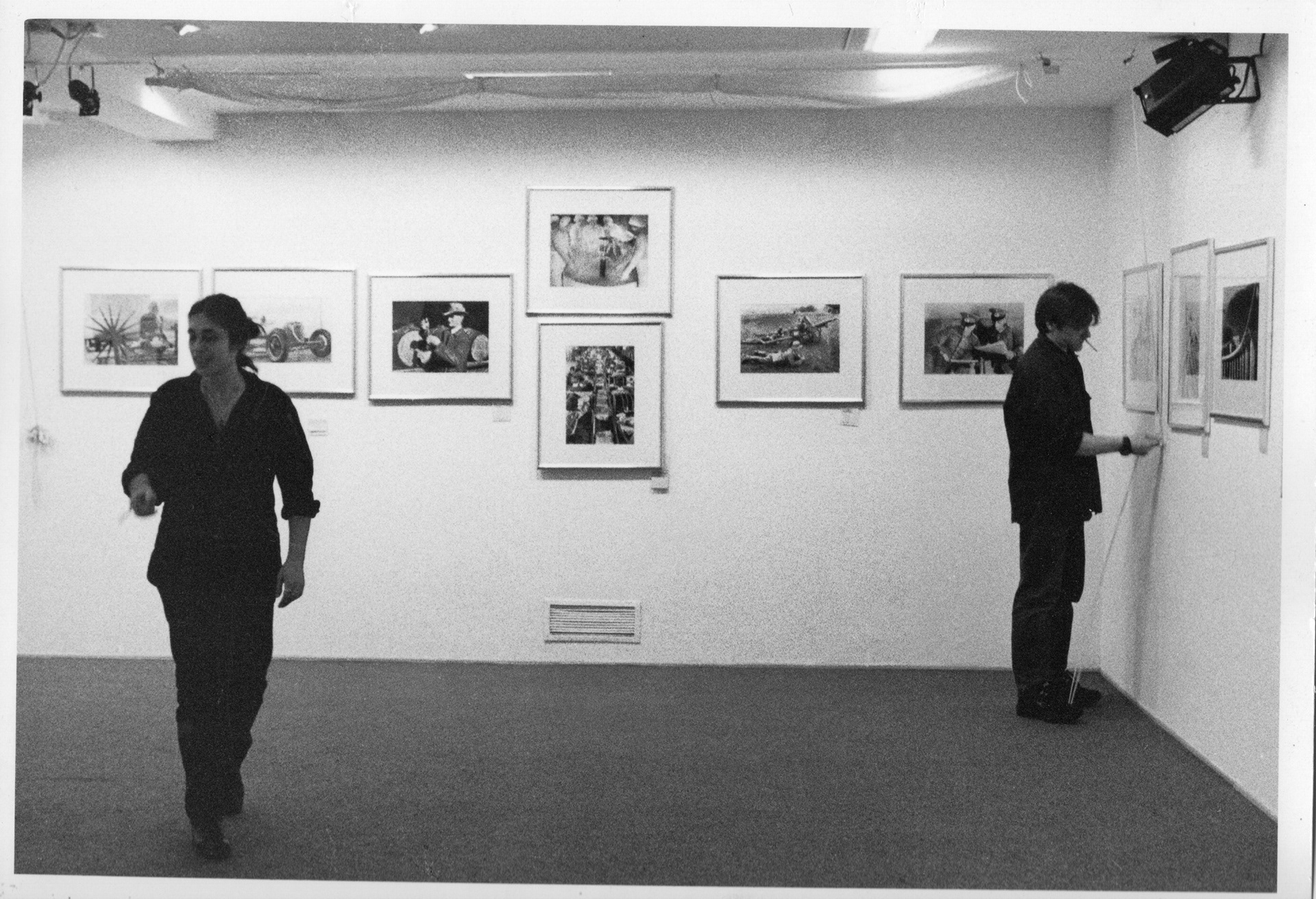
ph. Mara Granzotto
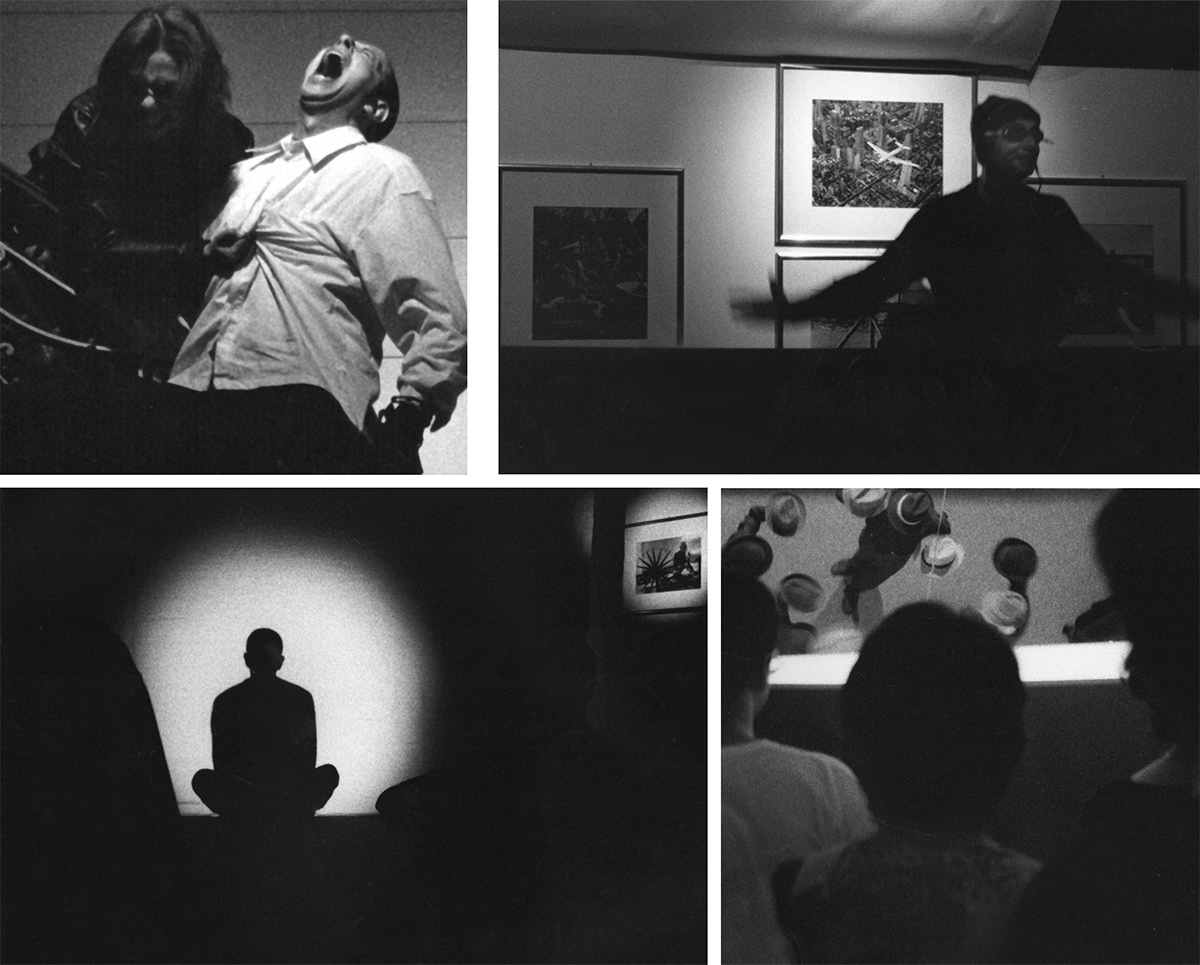
ph. Paola Mongelli - ph.Mara Granzotto

fig. 01 ph.: Mara Granzotto; fig. 02 - fig.03: ph. Paola Mongelli
GLI OCCHI DI LEONILDA - scritto e interpretato da Monica Bonetto
storytelling theater: real history of an old walking photographer
directed by: Monica Bonetto, Massimiliano Giacometti
with: Monica Bonetto, Beppe Rizzo
set design: Monica Chiappara
costume design: Roberta Vacchetta
light design: Davide Leone
artistic collaboration: Stefano dell'Accio
image processing: Caos
2009
location shooting: Teatro Settimo
SET DESIGN (ON STAGE) - PHOTO - POSTER
ph. © Monica Chiappara




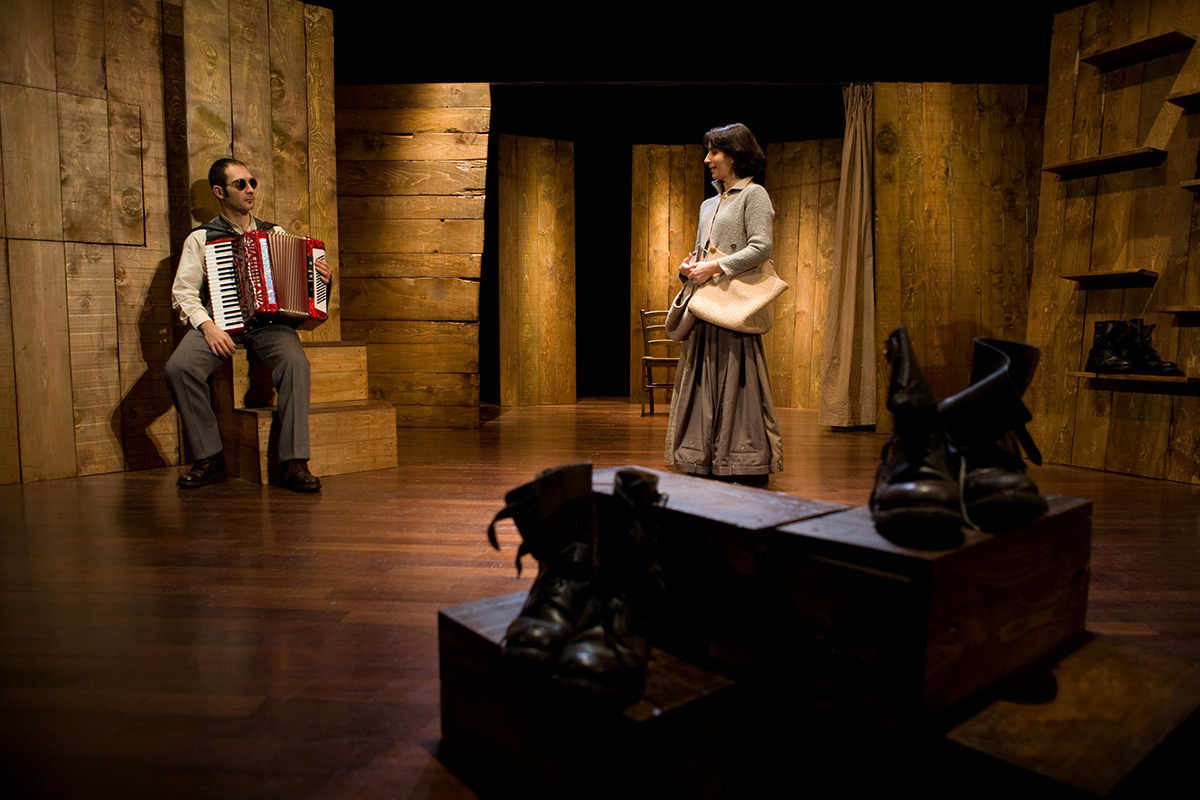
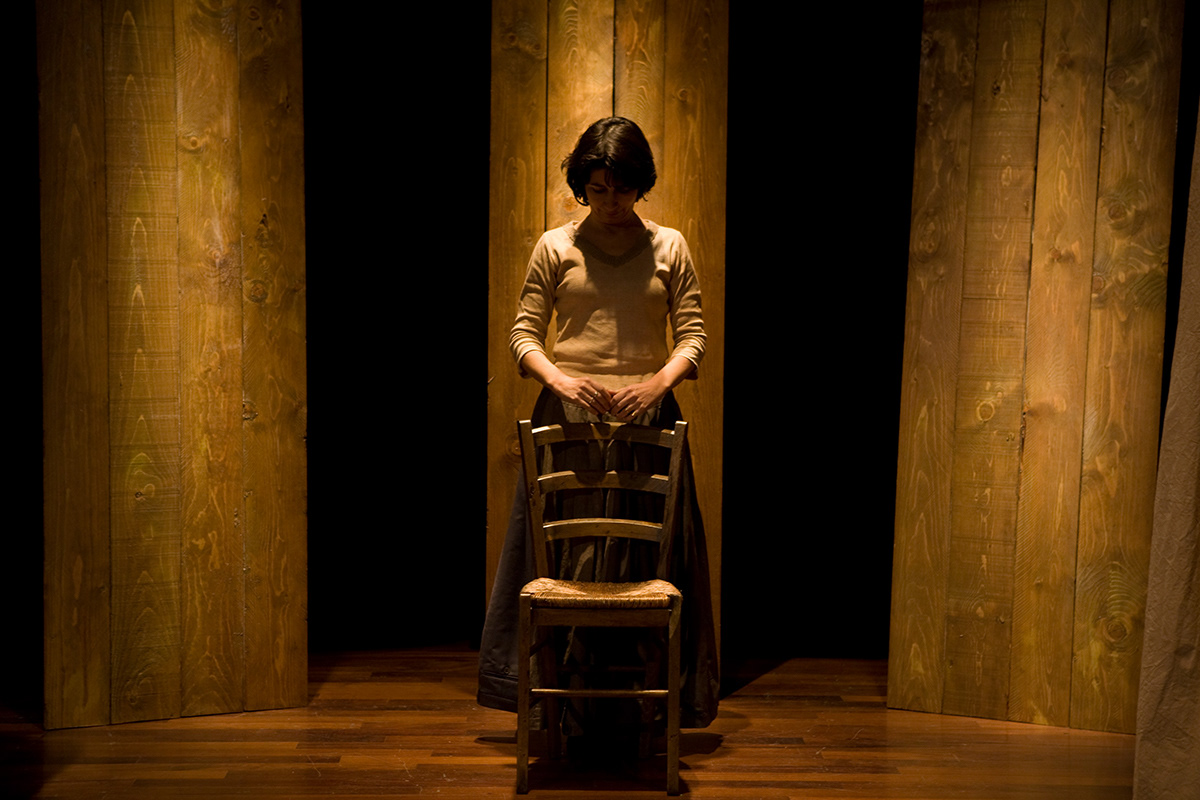
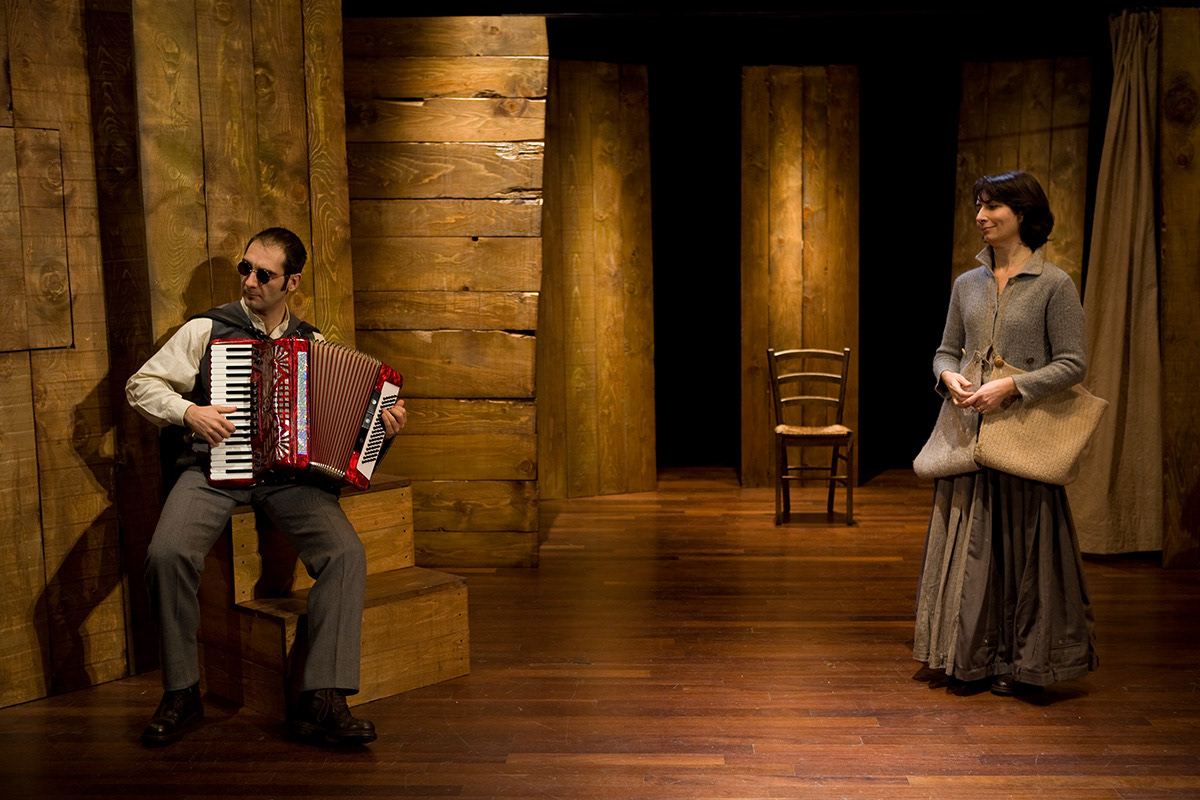
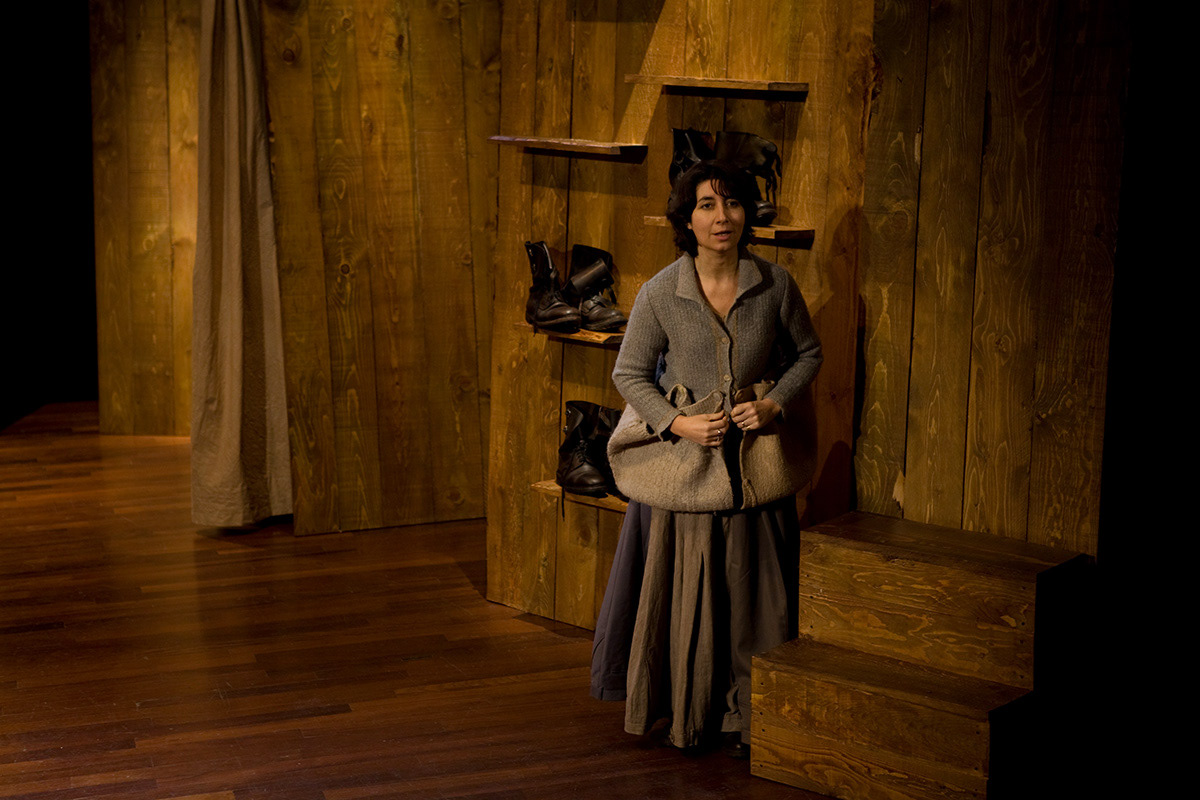
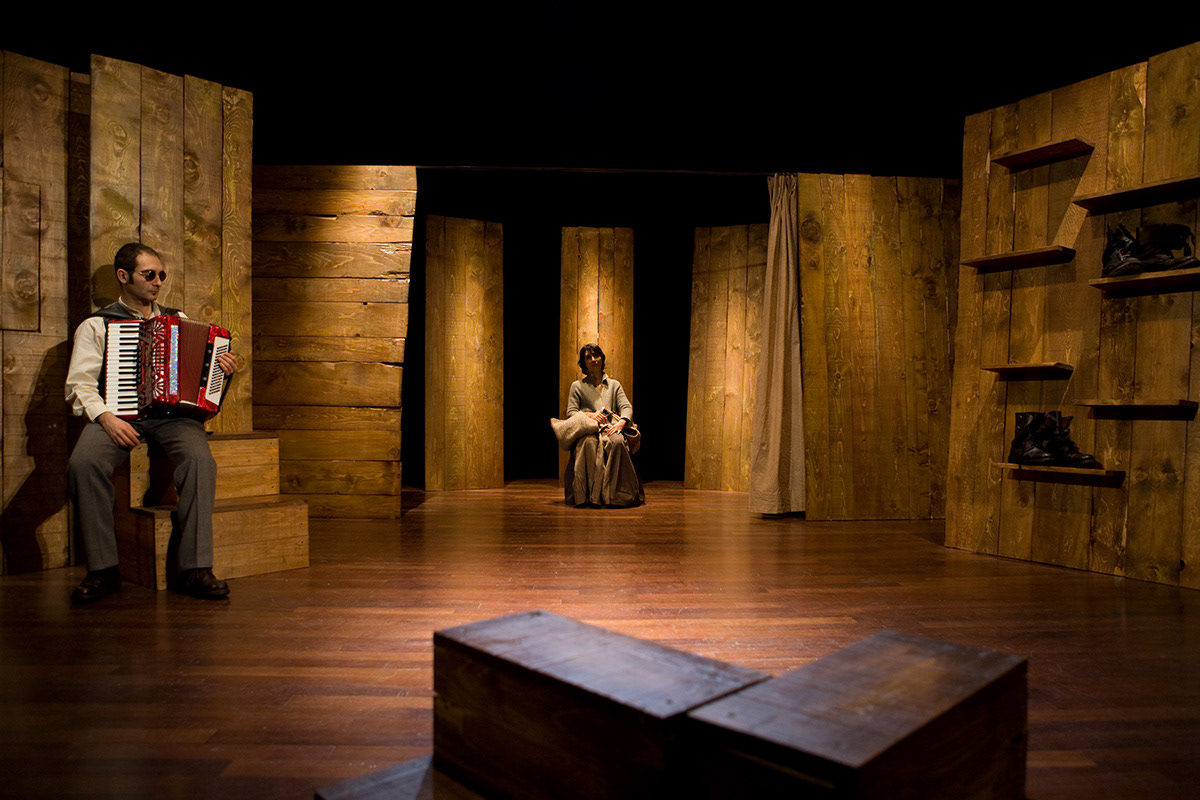
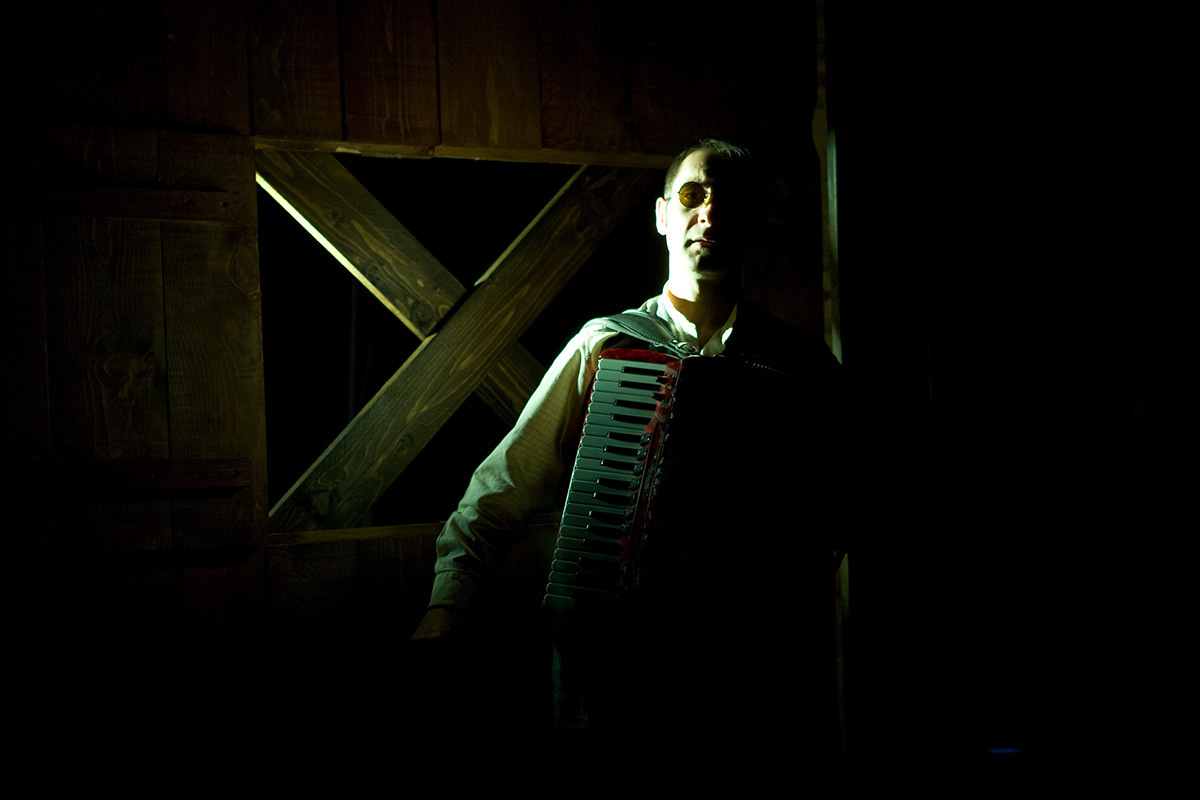
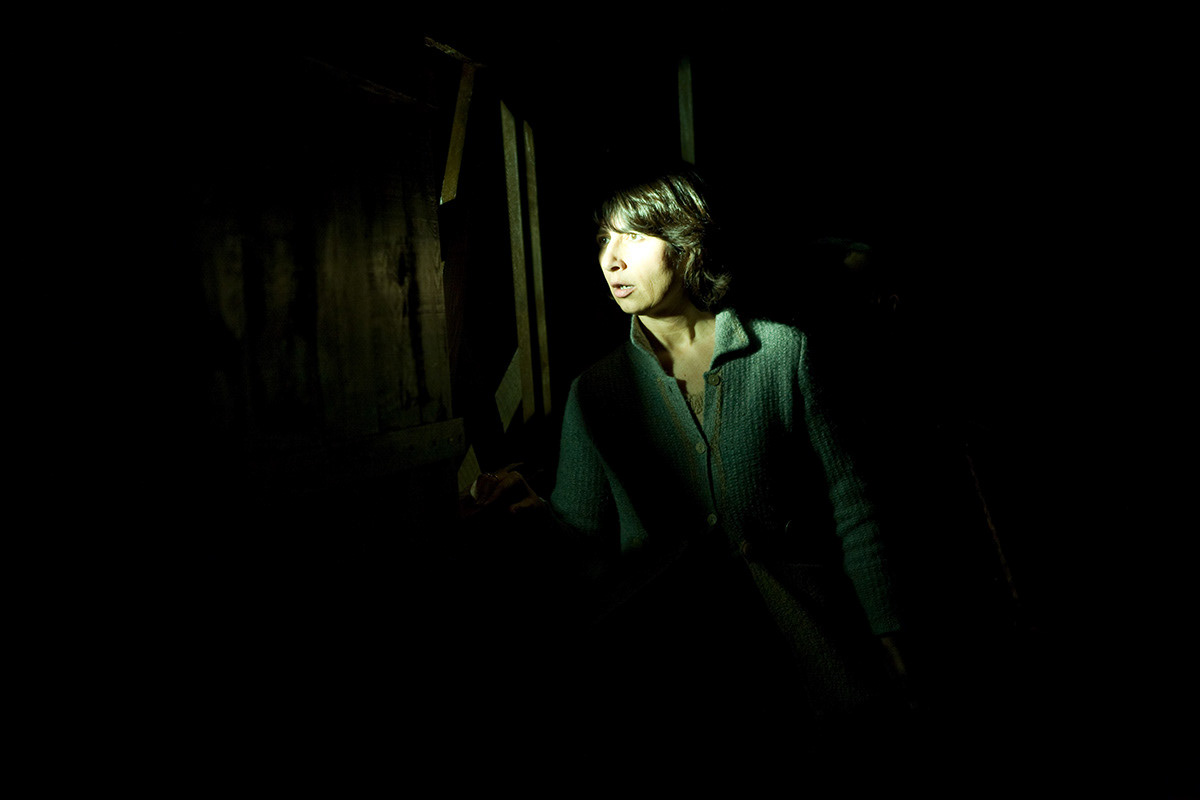
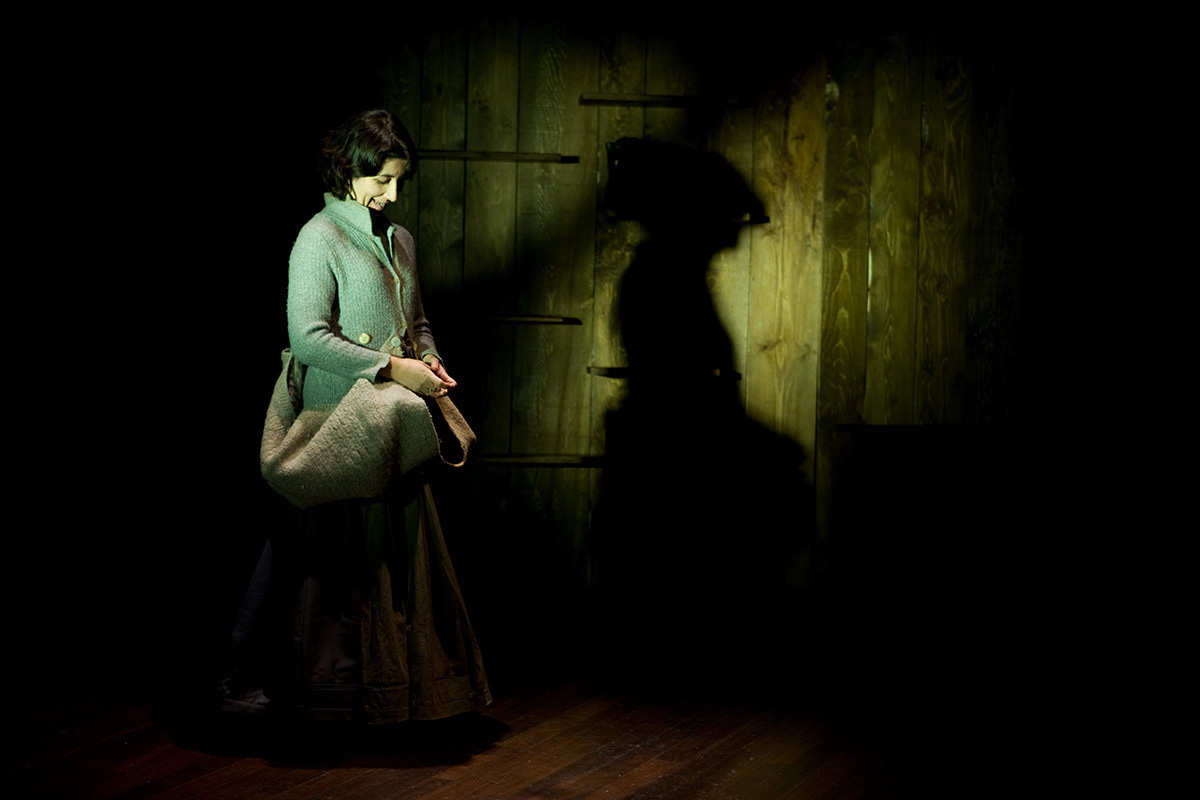

GLI OCCHI DI LEONILDA - LA SCENA IN COSTRUZIONE/ THE SCENE WHEN WAS UNDER CONSTRUCTION
